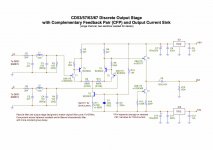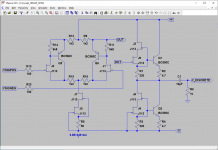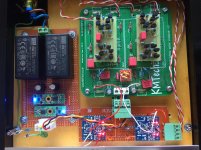Hi,
I am trying to do a discrete differential to SE input buffer for my active crossover. After good experience with J113 based buffers, I found this design (CD53_CFP_DiscreteOutputStage.jpg) somewhere on google picture search and adopted it. Two things I would like to improve:
1. Active load for the LTP input. I tried to replace R9/R12 with a current mirror, but had no luck. Could not get a working sinus signal
2. Simple solution to get rid of the output cap C1.
I would be happy for any suggestions.
Regards,
Michael
I am trying to do a discrete differential to SE input buffer for my active crossover. After good experience with J113 based buffers, I found this design (CD53_CFP_DiscreteOutputStage.jpg) somewhere on google picture search and adopted it. Two things I would like to improve:
1. Active load for the LTP input. I tried to replace R9/R12 with a current mirror, but had no luck. Could not get a working sinus signal
2. Simple solution to get rid of the output cap C1.
I would be happy for any suggestions.
Regards,
Michael
Attachments
You can take a look at this and ee how you can convert it to a single ended version (using only the top half of the complementary circuit).
And also using devices of your own choice.
XCEN Balanced to Single-Ended Converter Revisited
Best of luck,
Patrick
And also using devices of your own choice.
XCEN Balanced to Single-Ended Converter Revisited
Best of luck,
Patrick
Hi Patrick,
thank you very much for your advice. I will try and post the results.
Regards,
Michael
thank you very much for your advice. I will try and post the results.
Regards,
Michael
Do try out the 2SK209 and the others listed in my spice file.
They are very nice devices. IMHO better than J113, BC550, etc.
See :
NJFETs for Source Follower Applications
Also IMHO there is no need to use CFP, unless you need to drive low impedance load.
Just look at the FFT figures from the Spice file.
Patrick
They are very nice devices. IMHO better than J113, BC550, etc.
See :
NJFETs for Source Follower Applications
Also IMHO there is no need to use CFP, unless you need to drive low impedance load.
Just look at the FFT figures from the Spice file.
Patrick
That depends on what you want to achieve.
In the original version of the XCEN, the circuit is much simpler.
The XCEN -- Balanced to Single Ended Converter
But it does drift some mV with temperature, for me too much.
So as explained in the pdf document, things are added to ensure good thermal tracking.
Of course you can also use a servo, if you count an opamp as one component.
O just accept the few mV offset drift.
Cheers,
Patrick
In the original version of the XCEN, the circuit is much simpler.
The XCEN -- Balanced to Single Ended Converter
But it does drift some mV with temperature, for me too much.
So as explained in the pdf document, things are added to ensure good thermal tracking.
Of course you can also use a servo, if you count an opamp as one component.
O just accept the few mV offset drift.
Cheers,
Patrick
Absolutely, the THD figures really look good. Below 0.00x. Hmm, I wanted to move over to SMD since good through-hole parts become more and more obsolete. I might give it a shot 🙂 Is there any reason you use MOSFETs instead of BJTs?
Michael
Michael
> Is there any reason you use MOSFETs instead of BJTs?
Look at the values of R22/C1.
If you download the pictures of the original XCEN 2018, it can be a good basis for your PCB deisgn.
Only a couple of minor changes necessary.
Pretty sure you can manage.
Patrick
Look at the values of R22/C1.
If you download the pictures of the original XCEN 2018, it can be a good basis for your PCB deisgn.
Only a couple of minor changes necessary.
Pretty sure you can manage.
Patrick
Send me a PM with your email address.
I'll give you a few more hints, if you intend to build.
Patrick
I'll give you a few more hints, if you intend to build.
Patrick
A question was raised as to whether it can work with 10V rails.
With some minor changes, it can.
But the price is 10dB higher H2 (according to Spice), while H3 about 5dB higher.
The numbers are still good by any standard.
So it depends on your priorities.
Patrick
.
With some minor changes, it can.
But the price is 10dB higher H2 (according to Spice), while H3 about 5dB higher.
The numbers are still good by any standard.
So it depends on your priorities.
Patrick
.
Attachments
Finally I got the PCBs, that Patrick sent to me up and running. What should I say: This is clearly an improvement over all Opamp based circuits I tried so far. A highly transparent component, with clarity and a lot of more detail.
Thank you very much Patrick 🙂
Thank you very much Patrick 🙂
Attachments
- Home
- Source & Line
- Analog Line Level
- Advice needed with a discrete JFET differential to SE input buffer


